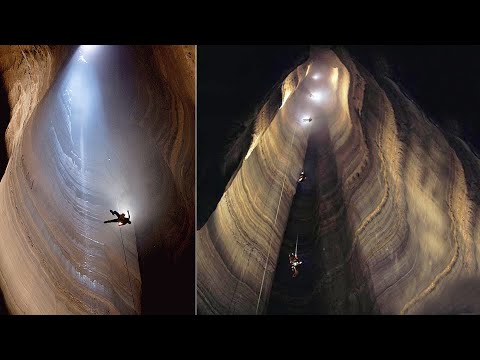
Caving, also known as spelunking in North America, is the recreational pastime of exploring wild cave systems. While the beauty of stalactites and stalagmites can be mesmerizing, caving is not for the faint-hearted—it requires physical stamina, psychological fortitude, and specialized equipment. Among these subterranean landscapes, some stand out not just for their depths but also for the sheer challenge they pose to those daring enough to enter them. Here are 10 of the deepest and most terrifying caves on our planet:
### 1. **Veryovkina Cave**
Located in Abkhazia, Georgia, Veryovkina Cave is currently considered the deepest cave in the world. Reaching a depth of 2,212 meters (7,257 feet), it was explored by a team of Russian speleologists. The cave’s extensive vertical pitch and cold, wet conditions make it an extremely challenging environment even for experienced cavers.
### 2. **Krubera Cave**
Also known as Voronya Cave and situated in Abkhazia, Krubera Cave was once considered the deepest cave on Earth until Veryovkina took over that title. It plunges approximately 2,197 meters (7,208 feet) deep into the earth’s crust. Its narrow passages and sumps add layers of complexity to any expedition.
### 3. **Lamprechtsofen**
Found in Austria’s Leogang Mountains, Lamprechtsofen reaches depths close to 1,632 meters (5,354 feet), making it one of Europe’s deepest caves. Known for its massive entrance portal which belies much narrower underground passages beyond, it presents significant challenges due to flooding risks.
### 4. **Gouffre Mirolda**
Situated in France’s Rhône-Alpes region, Gouffre Mirolda impressively descends about 1,733 meters (5,685 feet). It demands high technical skills especially due to its verticality and water hazards within some sections.
### 5. **Illyuzia-Mezhonnogo-Snezhnaya**
This cave located in Abkhazia dives down to approximately 1,753 meters (5,751 feet). The presence of ice within makes it not just deep but bitterly cold—a combination that can test even seasoned adventurers.
### 6. **Torca del Cerro del Cuevon**
In Spain’s Picos de Europa mountains lies Torca del Cerro del Cuevon with a depth reaching around 1,589 meters (5,213 feet). Its remote location adds an extra layer of difficulty for rescue operations in cases of emergency.
### 7. **Sistema Huautla**
Mexico’s Sistema Huautla is perhaps one of the most complex cave systems globally at a depth of about 1,545 meters (5,069 feet). It features tight squeezes combined with large chambers filled with beautiful rock formations—but navigating its labyrinthine corridors requires excellent mapping skills.
### 8. **Sima de la Cornisa – Torca Magali**
Another entry from Spain’s rugged Picos de Europa region; this system has been explored to depths approaching around -1 Medial Shaft: Sima de la Cornisa at -1509m (-4947 ft) & Torca Magali at -1169m (-3835 ft).
### 9. **Gouffre Jean Bernard**
This French cave near Samoëns dives nearly -1600 meters (-5249 feet) into limestone layers offering breathtaking views but also poses risks like rockfall and hypothermia due to its chilly interior temperatures.
###10 .**Callao Cave**
Callao Cave in the Philippines might not compare with others on this list concerning depth since it extends only around -300 meters (-984 feet); however ,its archaeological significance coupled with its natural beauty filled with cathedral-like chambers renders it both fascinating yet spooky due to human fossils found there including remains attributed potentially as new species Homo luzonensis_ _ making one wonder what lies beneath_._
Exploring any of these caves involves more than just physical endurance; it requires meticulous planning_ ,_ adaptability ,, profound respect for nature’ s power _,_ advanced technical abilities _,_teamwork_,and an unyielding spirit Adventure seekers should ensure they are well-prepared before attempting these perilous descents into Earth ‘s dark underbelly__.__
